Menu
Math Lesson 8.2.1 - Types of Formulas
Please provide a rating, it takes seconds and helps us to keep this resource free for all to use
Welcome to our Math lesson on Types of Formulas, this is the first lesson of our suite of math lessons covering the topic of Types of Formulas. Rearranging Formulas, you can find links to the other lessons within this tutorial and access additional Math learning resources below this lesson.
Types of Formulas
Formulas are classified into the following categories based on the purpose they are used for:
Algebra Formulas
Algebra formulas are used in equations, inequalities, wordy problems, etc. We consider as formulas all identities that are expressed in the form of properties. The eight basic algebraic identities, all properties of indices, roots, ratios and proportion, the formula of percentage, etc., are all examples of algebraic formulas. We have explained all of them in the previous chapters.
Other algebraic formulas we will see in the next chapters include: the quadratic formula; arithmetic and geometric series formulas by which we calculate the value of n-th term or the sum of n terms of such series; and so on.
Example 1
The sides of a cube are constructed using bars that are made of two different materials, A and B. Write a formula that gives the spatial relationship between the two materials present in the cube if the ratio between the lengths of A and B is the same everywhere.
Solution 1
To consider the 'spatial relationship' between the two materials we must find a formula that shows how these quantities are combined in the volume of the cube. Since the two materials are combined at the same ratio, we have A + B = constant, as the cube sides have the same length. From geometry we know that the volume of a cube is calculated by raising the side length to the third power. Hence, we have
This expression represents one of the eight special algebraic identities (cube of a sum). When expanded, it becomes
Hence, the expression for volume in terms of materials A and B for such a cube is
Geometry Formulas
Geometry is the branch that probably contains the largest number of formulas; from perimeter and area of various shapes to volume of solid objects; from trigonometry to polygons; from plane to space geometry and so on.
We will deal with all these fields and others in the upcoming chapters of this course. Here, we are going to illustrate the concept of geometric formulas with a simple example.
Example 2
- Given the formula of the circumference of a circle (C = 2πr) where r is the radius and π is a constant (π ≈ 3.14) and that of the area of a circle (A = πr2), find the formula for the total area of a thin and hollow cylinder, if the height H is known.
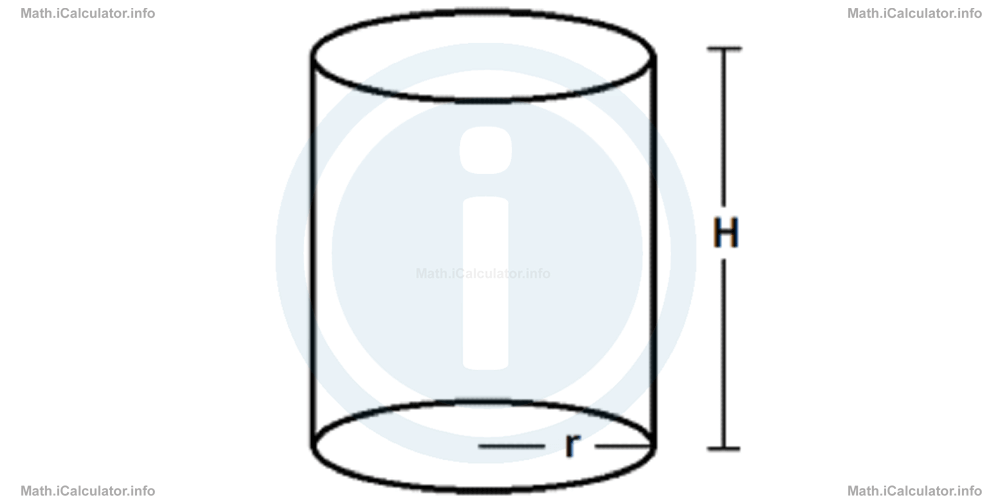
- The cylinder is melted down to produce a sphere with the same material. The sphere is also thin and hollow. What is the r/R ratio if r is the base radius of cylinder and R is the radius of the sphere? Take the height H of cylinder as twice the base radius. The area of sphere is calculated by the formula As = 4πR2.
Solution 2
- A cylinder is made by two identical circles called 'bases' and one lateral face that is not plane but it is instead curved according to the circles (bases) shape. The cylinder's opening is shown below.
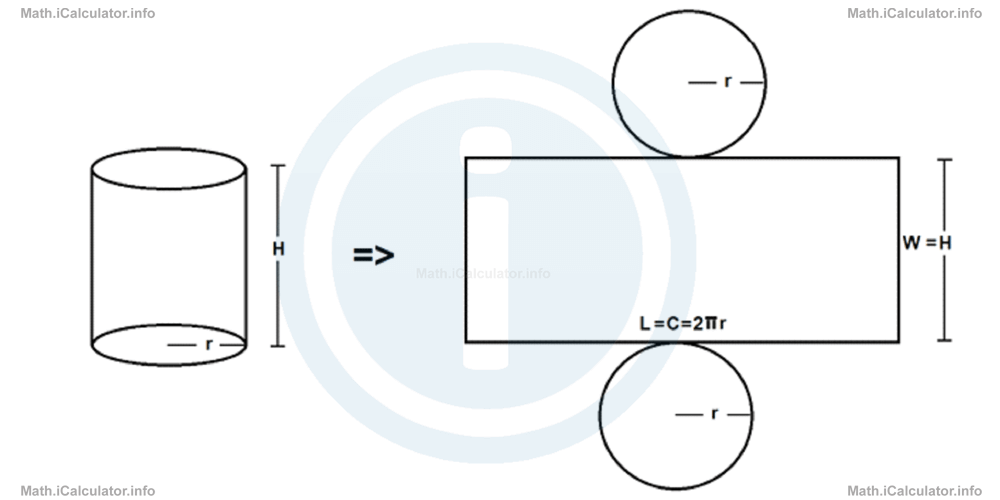 From the openings shown above, it is clear that lateral face is a rectangle, where the length L corresponds to the circumference of the circle (base) and width W corresponds to the cylinder's height. Therefore, giving that the area of a rectangle is the product of its length and height, we can write for the total surface area of the cylinder: Atot = 2Abase + Alateral
From the openings shown above, it is clear that lateral face is a rectangle, where the length L corresponds to the circumference of the circle (base) and width W corresponds to the cylinder's height. Therefore, giving that the area of a rectangle is the product of its length and height, we can write for the total surface area of the cylinder: Atot = 2Abase + Alateral
= 2 ∙ πr2 + L ∙ H
= 2πr2 + 2πrH
= 2πr(r + H) - Since both solids shapes are thin and hollow, they have the same surface area. Therefore, we can write AC = ASSince in the specific case H = 2r, we obtain
2πr(r + H) = 4πR22πr(r + 2r) = 4πR2
2r ∙ 3r = 4R2
6r2 = 4R2
r2/R2 = 4/6
(r/R)2 = (√4/√6)2
r/R = √4/√6
= 2/√6
= 2√6/(√6)2
= 2√6/6
= √6/3
Physics Formulas
Physics is another field of science that contains a very large number of formulas. From kinematics to dynamics; from work and energy to momentum and impulse; from electricity to magnetism and electromagnetism; from optics to modern physics etc., all these sub-branches of Physics contain in their theory many formulas each. Let's consider an example in this regard.
Example 3
Find the formula for the equivalent resistance R of two resistors R1 and R2 connected in parallel in the same electric circuit supplied by a source of potential difference (voltage) ΔV. Take into account the Ohm's Law ΔV = I · R where I is the current flowing through the circuit. To understand how current behaves in a parallel combination of resistors, use the analogy of water when splits in two separate branches. In addition, make use of the fact that the potential difference in a parallel branch is equal across each resistor; in absence of other resistors in the circuit it is equal to the potential difference at the source (battery).
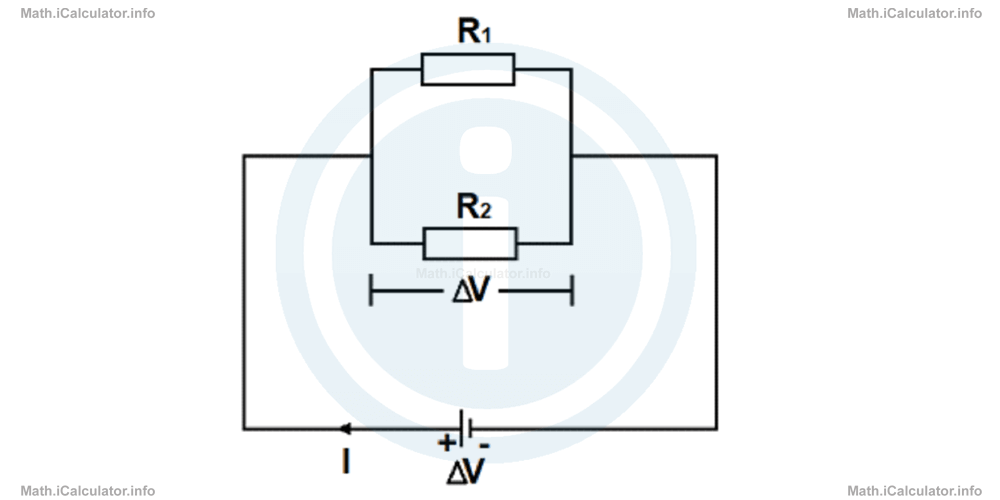
Solution 3
The current I divides in two parts, I1 and I2 (one for each parallel branch), like water in a river that divides in two different streams. Giving that the potential difference is the same across each resistor (ΔV1 = ΔV2 = ΔV) we can write based on the Ohm's Law:
∆V1)/R1 + ∆V2/R2 = ∆V/R
∆V/R1 + ∆V/R2 = ∆V/R
∆V(1/R1 + 1/R2 ) = ∆V/R
Simplifying ΔV from both sides yields:
This is the formula for the equivalent resistance of a parallel combination of two resistors.
Chemistry Formulas (compounds)
Chemistry is also a branch of science that contains many formulas, where the most notorious are the molecular formula that show how atoms are combined in molecules; stoichiometric formulas that are mostly based on Formula Mass, i.e. in the sum of the atomic weights of each atom present in the molecule of the substance; element percentages formulas in compounds, etc. As illustration, we will take here an example with element percentages in compounds.
Example 4
A compound made from two substances A and B has the following formula:
where m(B) = 2.7m(A). If the original mass of the compound is 74g, how much from the substance A must be added in the compound to obtain a new compound where m(B) = 2m(A) without changing the amount of B?
Solution 4
Let's denote by x the extra amount we must add to A in order to obtain the new compound. We have
so,
3.7m(A) = 74
m(A) = 74/3.7
= 20g
Hence,
When adding x gram from substance A in the compound, we will obtain m(B) = 2m(A + x). Thus, since m(B) does not change, we will have
54 = 2(20 + x)
54 = 2 ∙ 20 + 2x
54 = 40 + 2x
54 - 40 = 2x
14 = 2x
x = 14/2
x = 7g
Therefore, we must add 7g from the substance A in the compound to obtain the new ratio.
Another situation that requires the use of formulas in chemistry involves the calculation of the percentage composition of an element in a compound. Thus, if we have a compound of generic formula AxByCz, the total masses per mole of A, B and C are x · MA, y · MB and z · MC respectively. Thus, the mass percentage composition of element A in the compound is
For example, percent composition of hydrogen (H2) in sulfuric acid (H2SO4) giving that molar mass of hydrogen is 1.008 u, that of oxygen is 15.999 u and molar mass of sulfur is 32.07 u (u is an abbreviation for atomic mass unit), is
= 2 ∙ 1.008/2 ∙ 1.008 + 1 ∙ 32.07 + 4 ∙ 15.999 × 100%
= 2.016/2.016 + 32.07 + 63.996 × 100%
= 2.016/2.016 + 32.07 + 63.996 × 100%
= 2.016/98.082 × 100%
= 0.02055 × 100%
= 2.055%
Spreadsheet Formulas
A spreadsheet formula is an equation that performs a calculation on the numbers, functions and values of one or more cells. A formula is associated with a cell or a cell range. In the formula bar, we must write the 'equal to' sign first, then the name of formula; then we open the brackets where the name of the first and the last cell separated by a semicolon are written. After closing the brackets, we click on the cell in which we want the result to appear, then we press ENTER and the result appears in the designed cell.
Example 5
The student scores for three classes in a math exam are show in the table below extracted from an excel spreadsheet.
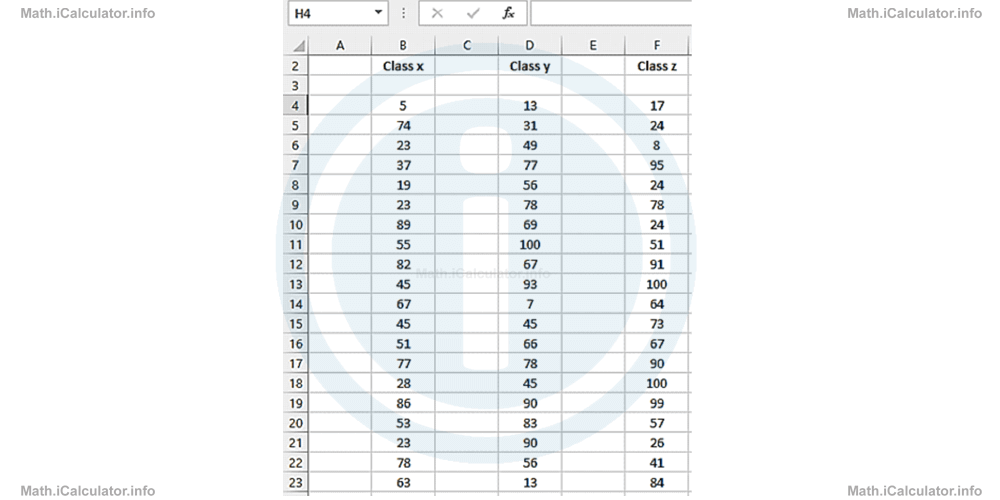
- Which class had the best average score in the exam?
- What is the average score of all students?
Solution 5
- We have to calculate the average score for each class separately and compare the values obtained. In excel there is a function that has a formula called AVERAGE, which we can use to avoid manual calculations. We write " = AVERAGE(B4:B23)"; " = AVERAGE(D4:D23)"; and "AVERAGE(F4:F23)" in the formula bar and the results obtained we can insert for example in B25, D25 and F25 cells respectively, as shown below.
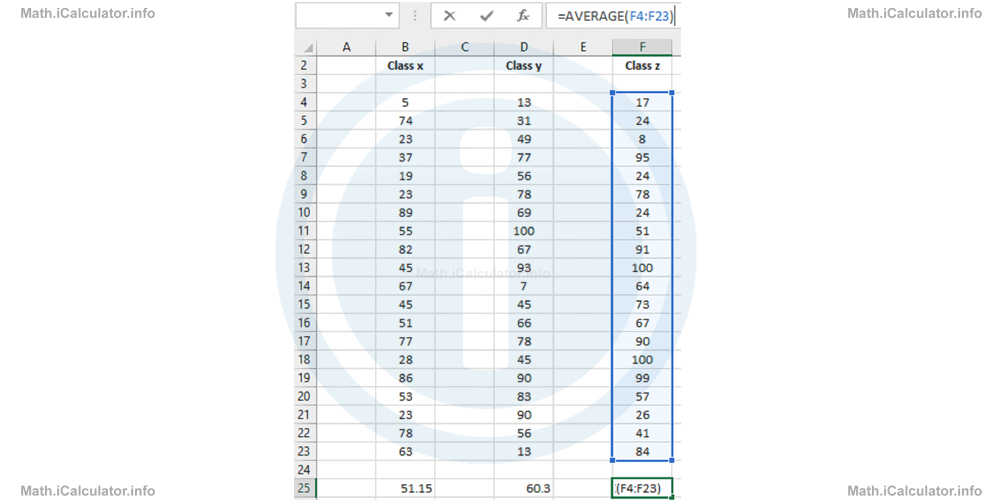 This done, we obtain the results 51.5, 60.3 and 60.65 respectively. Hence, comparing these average scores, it is evident that the class z had the highest score (60.65 points), then it comes the class y (60.3 points) and the class x, which had the lowest average score (51.15 points).
This done, we obtain the results 51.5, 60.3 and 60.65 respectively. Hence, comparing these average scores, it is evident that the class z had the highest score (60.65 points), then it comes the class y (60.3 points) and the class x, which had the lowest average score (51.15 points). - To find the average score of all students we can write in the formula bar the following command: " = AVERAGE(B25, C25, F25)". We can insert the result (57.3667) in another cell, for example in H25, as shown in the figure below.
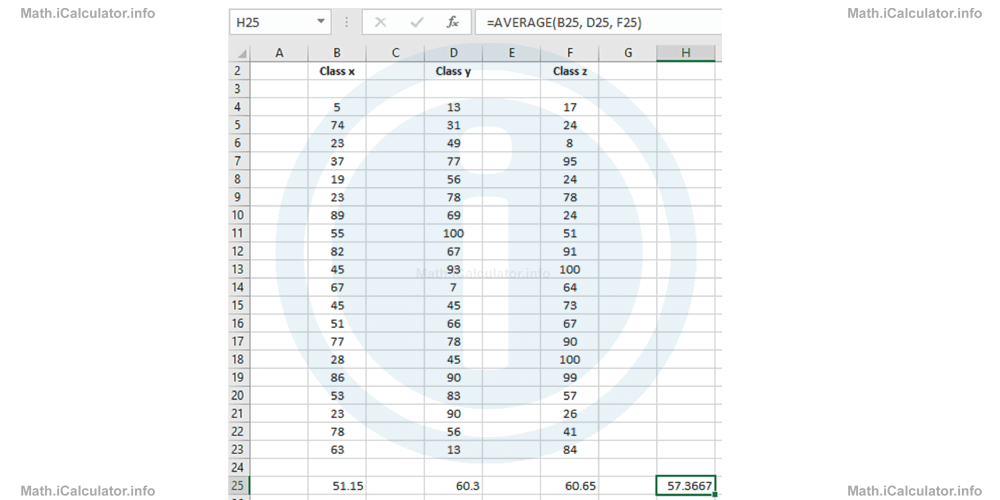 This procedure avoids long manual calculations that may also result in errors.
This procedure avoids long manual calculations that may also result in errors.
Banking Formulas (interest)
We explained in tutorial 5.4 the concepts of simple and compound interest. Thus, if the principal (original amount deposited or borrowed) if P and the simple interest rate is r, the formula used for calculating the total amount A(t) to be received or paid after a period t is
For example, if a customer deposits $20,000 in a bank (P = 20,000) that applies simple annual interest rates of 4% (we write it as a decimal, i.e. r = 4% = 0.04), the amount this customer will have in her savings account after 6 years of deposit (t = 6) will be
= 20,000(1 + 0.04∙6)
= 20,000(1 + 0.24)
= 20,000 ∙ 1.24
= 24,800
Therefore, the customer will have $24,800 in her saving account after 6 years of deposit.
Likewise, if a customer makes a $25,000 deposit (P = 25,000) in his savings account in a bank that applies 2.5% interest rates (r = 2.4% = 0.024) compounded twice in a year (n = 3), he will have in his account after four years of deposit (t = 4)
= 25,000(1 + 0.024/3)3 ∙ 4
= 25,000(1 + 0.008)12
= 25,000 ∙ 1.00812
= 25,000 ∙ 1.1003
= 27,507.5
Hence, the customer will have $27,507.5 in his savings account after four years.
Example 6
A customer wants to deposit $5,000 in a bank for 3 years. He has two saving accounts: one in the bank A that offers 4% simple annual interest rates and the other in the bank B that offers 2% interest rates compound twice in a year. What bank do you suggest that she choose?
Solution 6
We must calculate the amounts A(SI) and A(CI) and compare them, where SI stands for simple interest while CI for the compound interest. Obviously, we must use the simple interest formula for the bank A and compound interest formula for the bank B.
We have the following clues:
t = 3
r(SI) = 4% = 0.04
r(CI) = 2% = 0.02
n = 2
A(SI) = ?
A(CI) = ?
The amount the customer will have in her savings account in the bank A after three years of deposit is
= 5,000(1 + 0.04∙3)
= 5,000(1 + 0.12)
= 5,000 ∙ 1.12
= 5,600
The amount the customer will have in her savings account in the bank B after three years of deposit is
= 5,000(1 + 0.02/2)2 ∙ 3
= 5,000(1 + 0.01)6
= 5,000 ∙ 1.016
= 5,000 ∙ 1.0615
= 5,307.5
Thus, the customer will earn more if she deposits her savings in the bank A.
Engineering Formulas
Engineering is a branch of science that consists in the application in practice of science and math to solve problems. Engineers figure out how things work and find practical uses for scientific discoveries. In this sense, engineering is the combination of math and other natural sciences. Calculations and formulas in engineering are usually more complicated than in physics or math. There are many engineering sub-branches, such as mechanical engineering, civil engineering, computer engineering, electrical engineering, etc. We will illustrate the use of formula with an example in mechanical engineering, which deals with structure's construction.
Example 7
What is the maximum weight a 1.200 m long and 2.0 cm2 thick iron bar can hold when hooked vertically from the ceiling of a strong structure? The Young Modulus E is a constant that represents the strength of material; for iron is 1011 N/m2 and it is calculated by dividing stress σ (Force/Cross-sectional area) and Strain ε (Change in length/Original length). The breaking point of iron (the maximum elongation allowed without breaking) is reached when an iron bar extend up to 1/600 of its original length.
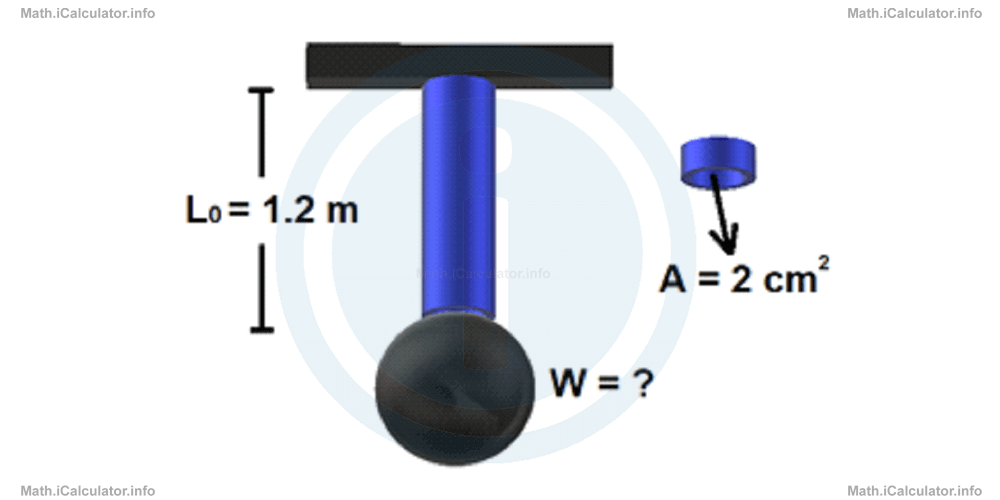
Solution 7
The force in the stress formula can be replaced with the weight W, as from physics it is known that weight is a kind of downward force. In addition, we must take into account the fact that the units of area change 100 by 100. Thus, 1 cm2 = 10 - 4 m2.
Other clues include:
A (cross-sectional area or thickness) = 2.0 cm2 = 0.00020 m2 = 2.0 × 10-4 m2
>ΔL (change in length or elongation) = 1/600 L0 = 1/600 × 1.200 m = 0.002 m = 2 × 10-3 m
E (Young's modulus) = 1011 N/m2
W = F = ?
Since
we obtain, by rearranging the last formula:
Hence, the maximum weight the iron bar can hold is
= (1011 N/m2 ) ∙ (2.0 × 10 - 4 m2 ) ∙ (2 × 10-3 m)/1.200 m
= 3.3333 × 104 N
= 33,333 N
More Types of Formulas. Rearranging Formulas Lessons and Learning Resources
Whats next?
Enjoy the "Types of Formulas" math lesson? People who liked the "Types of Formulas. Rearranging Formulas lesson found the following resources useful:
- Types Feedback. Helps other - Leave a rating for this types (see below)
- Formulas Math tutorial: Types of Formulas. Rearranging Formulas. Read the Types of Formulas. Rearranging Formulas math tutorial and build your math knowledge of Formulas
- Formulas Video tutorial: Types of Formulas. Rearranging Formulas. Watch or listen to the Types of Formulas. Rearranging Formulas video tutorial, a useful way to help you revise when travelling to and from school/college
- Formulas Revision Notes: Types of Formulas. Rearranging Formulas. Print the notes so you can revise the key points covered in the math tutorial for Types of Formulas. Rearranging Formulas
- Formulas Practice Questions: Types of Formulas. Rearranging Formulas. Test and improve your knowledge of Types of Formulas. Rearranging Formulas with example questins and answers
- Check your calculations for Formulas questions with our excellent Formulas calculators which contain full equations and calculations clearly displayed line by line. See the Formulas Calculators by iCalculator™ below.
- Continuing learning formulas - read our next math tutorial: Writing Formulas and Substituting in a Formula
Help others Learning Math just like you
Please provide a rating, it takes seconds and helps us to keep this resource free for all to use
We hope you found this Math tutorial "Types of Formulas. Rearranging Formulas" useful. If you did it would be great if you could spare the time to rate this math tutorial (simply click on the number of stars that match your assessment of this math learning aide) and/or share on social media, this helps us identify popular tutorials and calculators and expand our free learning resources to support our users around the world have free access to expand their knowledge of math and other disciplines.